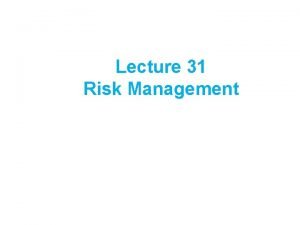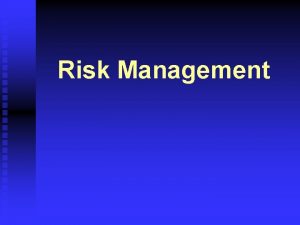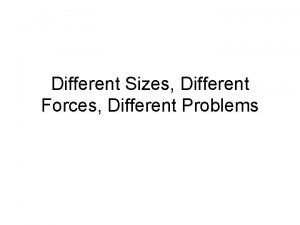Lecture 2 RISK Agenda Different Definitions of Risk











- Slides: 11

Lecture 2: RISK

Agenda • • • . Different Definitions of Risk Chance of Loss Peril and Hazard Classification of Risk Techniques for Managing Risk Hedging and Insurance 1 -2

Different Definitions of Risk • Risk: Uncertainty concerning the occurrence of a loss • Loss Exposure: Any situation or circumstance in which a loss is possible, regardless of whether a loss occurs. • Objective Risk vs. Subjective Risk – Objective risk is defined as the relative variation of actual loss from expected loss • It can be statistically calculated using a measure of dispersion, such as the standard deviation – Subjective risk is defined as uncertainty based on a person’s mental condition or state of mind • Two persons in the same situation may have different perceptions of risk • High subjective risk often results in conservative behavior. 1 -3

Chance of Loss • Chance of loss: The probability that an event will occur • Objective Probability vs. Subjective Probability – Objective probability refers to the long-run relative frequency of an event assuming an infinite number of observations and no change in the underlying conditions • It can be determined by deductive or inductive reasoning – Subjective probability is the individual’s personal estimate of the chance of loss • A person’s perception of the chance of loss may differ from the objective probability . 1 -4

Peril and Hazard • A peril is defined as the cause of the loss – In an auto accident, the collision is the peril • A hazard is a condition that increases the chance of loss – Physical hazards are physical conditions that increase the chance of loss (icy roads, defective wiring) – Moral hazard is dishonesty or character defects in an individual, that increase the chance of loss (faking accidents, inflating claim amounts) – Attitudinal Hazard (Morale Hazard) is carelessness or indifference to a loss, which increases the frequency or severity of a loss (leaving keys in an unlocked car) – Legal Hazard refers to characteristics of the legal system or regulatory environment that increase the chance of loss (large damage awards in liability lawsuits). 1 -5

Classification of Risk • Pure and Speculative Risk – A pure risk is one in which there are only the possibilities of loss or no loss (earthquake) – A speculative risk is one in which both profit or loss are possible (gambling) • Diversifiable Risk and Nondiversifiable Risk – A diversifiable risk affects only individuals or small groups (car theft). It is also called nonsystematic or particular risk. – A nondiversifiable risk affects the entire economy or large numbers of persons or groups within the economy (hurricane). It is also called systematic risk or fundamental risk. – Government assistance may be necessary to insure nondiversifiable risks. . 1 -6

Classification of Risk • Enterprise risk encompasses all major risks faced by a business firm, which include: pure risk, speculative risk, strategic risk, operational risk, and financial risk – Financial Risk refers to the uncertainty of loss because of adverse changes in commodity prices, interest rates, foreign exchange rates, and the value of money. • Enterprise Risk Management combines into a single unified treatment program all major risks faced by the firm: – – – . Pure risk Speculative risk Strategic risk Operational risk Financial risk 1 -7

Major Personal Risks and Commercial Risks • Personal risks involve the possibility of a loss or reduction in income, extra expenses or depletion of financial assets: – Premature death of family head – Insufficient income during retirement • Most workers are not saving enough for a comfortable retirement – Poor health (catastrophic medical bills and loss of earned income) – Involuntary unemployment. 1 -8

Techniques for Managing Risk • There are five major methods for managing risk – Avoidance – Loss control • Loss prevention refers to activities to reduce the frequency of losses • Loss reduction refers to activities to reduce the severity of losses – Retention • An individual or firm retains all or part of a given risk • Active retention means that an individual is consciously aware of the risk and deliberately plans to retain all or part of it • Passive retention means risks may be unknowingly retained because of ignorance, indifference, or laziness • Self Insurance is a special form of planned retention by which part or all of a given loss exposure is retained by the firm . 1 -9

Techniques for Managing Risk • Noninsurance transfers – A risk may be transferred to another party by several methods: – A transfer of risk by contract, such as through a service contract or a hold-harmless clause in a contract – Hedging is a technique for transferring the risk of unfavorable price fluctuations to a speculator by purchasing and selling futures contracts on an organized exchange – Incorporation of a business firm transfers to the creditors the risk of having insufficient assets to pay business debts • Insurance – For most people, insurance is the most practical method for handling a major risk . 1 -10

Insurance vs. Hedging Insurance • Risk is transferred by a contract • Insurance involves the transfer of insurable risks • Insurance can reduce the objective risk of an insurer through the Law of Large Numbers . Hedging • Risk is transferred by a contract • Hedging involves risks that are typically uninsurable • Hedging does not result in reduced risk 1 -11
 01:640:244 lecture notes - lecture 15: plat, idah, farad
01:640:244 lecture notes - lecture 15: plat, idah, farad Vaishvikaran
Vaishvikaran Agenda sistemica y agenda institucional
Agenda sistemica y agenda institucional Market risk credit risk operational risk
Market risk credit risk operational risk Risk management lecture
Risk management lecture Why do different polymers have different properties
Why do different polymers have different properties Technicolor test
Technicolor test Sound will travel at different speeds in different mediums.
Sound will travel at different speeds in different mediums. Sound will travel at different speeds in different mediums.
Sound will travel at different speeds in different mediums. Different culture have different moral codes
Different culture have different moral codes Different angle different story
Different angle different story Acid base song
Acid base song





















